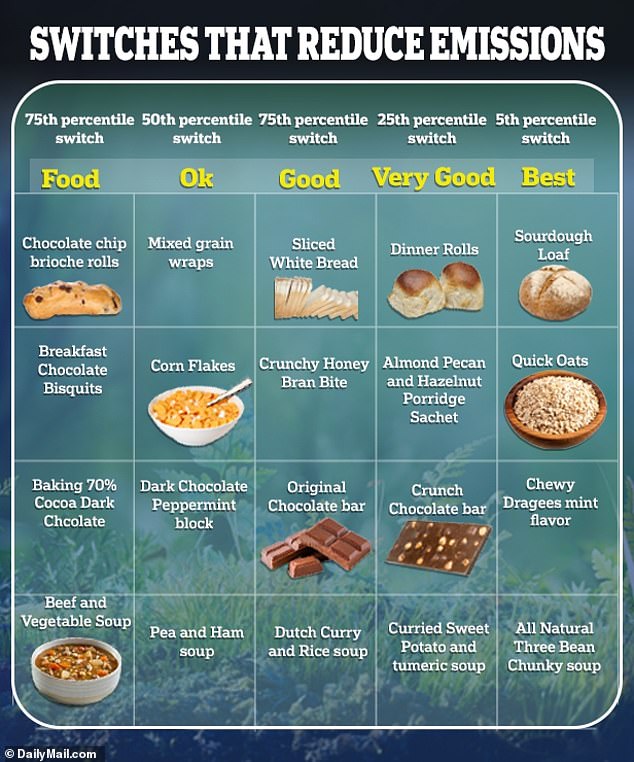If you want to save the planet, start by ditching beef lasagna.
Choosing the vegetarian alternative will slash the greenhouse gas emissions of your meal by as much as 71 percent, according to a new study.
Researchers looked at 22,000 products and assigned them to 12 common categories of groceries. They came up with eco friendly swaps between similar items, which will reduce emissions by 26 percent, as well as bigger swaps which are even more eco-friendly.
Swaps were suggested that would have varying impacts on emissions, based on the greenhouse gases each product generates when made.
Dairy, meat and processed food are detrimental to the environment because they require extensive land space, which is often created by cutting down trees, which releases carbon dioxide stored in trees into the atmosphere.
Lead author and epidemiologist Dr Allison Gaines, who conducted the analysis, said: ‘Dietary habits need to change significantly if we are to meet global emissions targets, particularly in high-income countries like Australia, the UK, and US.’
As called for in the Paris Agreements, global emissions need to be reduced by 45 percent by 2030 and reach net zero by 2050 in order to keep global warming to no more than 1.5 degrees Celsius.
In terms of soup, for instance, beef and vegetable soup was deemed as bad for the environment due to the large amount of greenhouse gases the meal creates.
A slightly better switch would be to pea and ham soup, because pigs require less food and water.
An even better switch would be to Dutch Curry and rice soup or curried sweet potato and turmeric soup, with the lack of meat significantly lowering the environmental impact.
The best switch would be to an all natural three bean chunky soup, because it is the least processed of the five options.
The more processed a food is, the more refining, transporting, and handling is needed, which all produce additional greenhouse gases.
Meat products produce a lot of greenhouse gas emissions due to the methane, nitrous oxide and carbon emissions of livestock and their supply chains.
What’s more, deforestation to make way for space to rear cattle reduces the amount of trees that absorb carbon dioxide.
Previous research from 2019 found that the percentage of all US emissions that are directly attributed to household consumption is only 20 percent.
Roughly 31 million tons of greenhouse gas emissions could be attributed to to products consumed at home in 2019, with the three highest contributors being meat, dairy, and non-alcoholic beverages.
It is estimated that only around one-third of global greenhouse gas emissions are attributable to the food and agriculture sector.
The researchers also recommended refraining from eating diary products such as a sweetened Greek style yoghurt with honey granola if you want to reduce your carbon footprint.
More preferable is a dairy apple and rhubarb twist yoghurt, because an apple-based yoghurt will generate less greenhouse gases than a cow’s milk one.
A fully developed cow is estimated to emit up to 500 liters of methane a day due to its digestive processes.
Even better would be a strawberry Greek style yoghurt or a strawberry yoghurt drink, as Greek yoghurt can be made with goat’s milk, and may contain other things like condensed milk instead of cow’s milk.
To really do your bit for the environment, researchers said the best switch would be to a non-dairy yoghurt, such as gluten free cultured coconut milk with vanilla yoghurt.
The production of diary results in significant greenhouse gas emissions such as methane, nitrous oxide, and carbon dioxide.
In terms of bread, chocolate chip brioche rolls were deemed the worse, followed by mixed grain wraps, sliced white bread and dinner rolls.
The switch that will reduce greenhouse gas emissions the most is to a sourdough loaf.
This is because sourdough entirely avoids the chemical fertilizers used in making commercial wheat and yeast, as well as the carbon used in transporting this wheat and yeast hundreds of miles from source to factory.
In America, the biggest source of the emissions in milk production are due to the production of food for the cattle, the methane cows give out during the digestive process, and the management of their manure.
Researchers calculated the projected emissions of annual grocery purchases from 7,000 Australian households, using information from The George Institute’s FoodSwitch database.
More than 22,000 products were assigned to categories of foods to quantify emissions saved by switching.
Source: Mail Online
